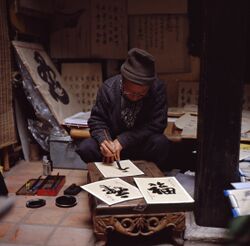Difference between revisions of "Calligraphy"
(Created page with "{{concept |wikipedia=https://en.wikipedia.org/wiki/Calligraphy |image= |constitutes= |interests= }} {{SMWDocs}} ==References== {{reflist}} {{Stub}}") |
(unstub) |
||
| Line 1: | Line 1: | ||
{{concept | {{concept | ||
|wikipedia=https://en.wikipedia.org/wiki/Calligraphy | |wikipedia=https://en.wikipedia.org/wiki/Calligraphy | ||
| − | |image= | + | |image=Caligraphy.jpg |
|constitutes= | |constitutes= | ||
|interests= | |interests= | ||
| + | |description=The design and execution of lettering with a pen, ink brush, or other writing instrument. | ||
}} | }} | ||
| + | '''Calligraphy''' is a visual art related to [[writing]]. It is the design and execution of [[lettering]] with a [[pen]], [[ink brush]], or other writing instrument. A contemporary calligraphic practice can be defined as "the art of giving form to signs in an expressive, harmonious, and skillful manner".<ref>Mediaville, Claude (1996). ''Calligraphy: From Calligraphy to Abstract Painting.'' Belgium: Scirpus-Publications. ISBN 978-90-803325-1-5.</ref> | ||
| + | |||
| + | Modern calligraphy ranges from functional inscriptions and designs to fine-art pieces where the letters may or may not be readable. Classical calligraphy differs from [[type design]] and non-classical hand-lettering, though a calligrapher may practice both.<ref> Pott, G. (2006). ''Kalligrafie: Intensiv Training'' [Calligraphy: Intensive Training] (in German). Verlag Hermann Schmidt. ISBN 978-3-87439-700-1.</ref> | ||
| + | |||
| + | In cultural history, calligraphy is held in high esteem wherever the copying of [[sacred texts]] is itself classified as a sacred process: for example, traditionally in [[Christianity]] when copying [[the Bible]], or in [[Islam]], where the basmala is the most common form of calligraphy. Calligraphy is still important and inspiring for the [[Chinese]] and [[Japanese]] writing culture today. Achieving perfect aesthetic balance and making emotions visible is more important than legibility. | ||
| + | |||
| + | Many calligraphers refer to the almost meditative character of their work: | ||
| + | |||
| + | :"The tranquility of this work fills the whole being with an all-encompassing satisfaction where time and space, as if wiped away for a short while, no longer bother us nor burden us." | ||
| + | |||
| + | :– Andreas Schenk<ref>Andreas Schenk: Kalligraphie: die stille Kunst, eine Feder zu führen: [das Werkbuch zum Schönschreiben]. AT-Verlag, 1989, ISBN 3-85502-375-1</ref> | ||
| + | |||
{{SMWDocs}} | {{SMWDocs}} | ||
==References== | ==References== | ||
{{reflist}} | {{reflist}} | ||
| − | {{ | + | |
| + | {{PageCredit | ||
| + | |site=Wikipedia | ||
| + | |date=06.06.2022 | ||
| + | |url=https://en.wikipedia.org/wiki/Calligraphy | ||
| + | }} | ||
Latest revision as of 23:16, 24 June 2022
 | |
| Interest of | Gordon Barrass |
| The design and execution of lettering with a pen, ink brush, or other writing instrument. | |
Calligraphy is a visual art related to writing. It is the design and execution of lettering with a pen, ink brush, or other writing instrument. A contemporary calligraphic practice can be defined as "the art of giving form to signs in an expressive, harmonious, and skillful manner".[1]
Modern calligraphy ranges from functional inscriptions and designs to fine-art pieces where the letters may or may not be readable. Classical calligraphy differs from type design and non-classical hand-lettering, though a calligrapher may practice both.[2]
In cultural history, calligraphy is held in high esteem wherever the copying of sacred texts is itself classified as a sacred process: for example, traditionally in Christianity when copying the Bible, or in Islam, where the basmala is the most common form of calligraphy. Calligraphy is still important and inspiring for the Chinese and Japanese writing culture today. Achieving perfect aesthetic balance and making emotions visible is more important than legibility.
Many calligraphers refer to the almost meditative character of their work:
- "The tranquility of this work fills the whole being with an all-encompassing satisfaction where time and space, as if wiped away for a short while, no longer bother us nor burden us."
- – Andreas Schenk[3]
References
- ↑ Mediaville, Claude (1996). Calligraphy: From Calligraphy to Abstract Painting. Belgium: Scirpus-Publications. ISBN 978-90-803325-1-5.
- ↑ Pott, G. (2006). Kalligrafie: Intensiv Training [Calligraphy: Intensive Training] (in German). Verlag Hermann Schmidt. ISBN 978-3-87439-700-1.
- ↑ Andreas Schenk: Kalligraphie: die stille Kunst, eine Feder zu führen: [das Werkbuch zum Schönschreiben]. AT-Verlag, 1989, ISBN 3-85502-375-1
Wikipedia is not affiliated with Wikispooks. Original page source here